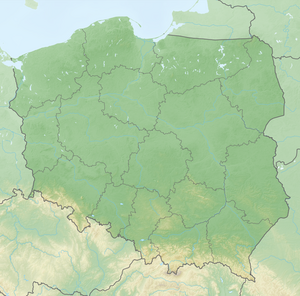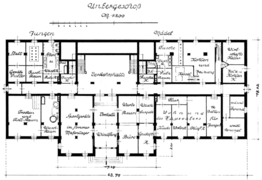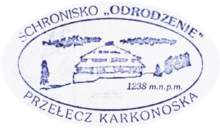Schronisko Odrodzenie
| Schronisko Odrodzenie (long name: Schronisko PTTK Odrodzenie na Przełęczy Karkonoskiej) PTTK- mining house / hotel |
||
|---|---|---|
|
The hostel in January 2005 |
||
| location | On the Spindlerpass ; Poland | |
| Mountain range | Giant Mountains , Sudetes | |
| Geographical location: | 50 ° 45 '48.4 " N , 15 ° 38' 22.8" E | |
| Altitude | 1236 m npm | |
|
|
||
| owner | PTTK | |
| Built | 1928/1929 | |
| Construction type | Mining lodge / hotel; Stone, wood | |
| Usual opening times | open all year | |
| accommodation | approx. 100 , unknown | |
| Web link | Site of the hut | |
The Schronisko Odrodzenie (long-term polish Schronisko PTTK Odrodzenie na Przełęczy Karkonoskiej translated: PTTK hostel rebirth on Karkonoska Pass , formerly Youth comb Haus Rübezahl ) is located at an altitude of 1236 m npm in Poland in the Giant Mountains , a mountain range of the Sudeten on the mountain pass Spindler pass .
history
Before 1933
Around the mid-20s of the 20th century, Dr. Hans Poeschel came up with the idea of building a youth camp in the Giant Mountains . Poeschel, who at that time was the district president in the Liegnitz administrative district , focused his attention particularly on boys and girls from the workers in the industrial areas of eastern Germany, who were in need after the First World War . The house should provide opportunities for visits and vacations all year round. The idea was widely recognized and widely supported by municipalities, associations, trade unions, companies and private individuals. It was thus possible to obtain the funds necessary for the construction very quickly.
The large landowner and last free landlord of the von Schaffgotsch family , Reichsgraf Friedrich (1883–1947) donated the building site in the immediate vicinity of the border between what was then Prussia and the Czechoslovak Republic .
The donation to the north-east of the Spindlerbaude contributed to the fact that considerable costs could be saved. Associated with the donation was the permission to extract a large part of the stones for the foundation walls and the ground floor from the granite rock in the vicinity.
On May 10, 1928, the building design competition was announced, won by Herbert Eras from Breslau . The renowned architect had planned the Schlesierhaus ( Schronisko Dom Śląski in Polish ) on Koppenplan a few years earlier at the beginning of the decade . Its compact, four-storey design was all in all designed for around 210 beds and should also offer space for 70-80 more hikers in a mass quarter.
The shape of the building is reminiscent of a stepped pyramid , because the upper floors in the timber framework are set back as so-called staggered floors compared to the floor below and have a smaller footprint. In addition to the effect of harmoniously fitting into the ridge location, this construction method offers a further advantage. Time and again, mining towns have been hit by devastating fires. In such a case, the upper floors would be easier to clear than would be possible with another multi-storey construction. The builder endeavored at all to secure the residents against the risk of fire. Stone stairs lead between the two brick stairwells to the top floor.
The height of the building is 16 meters. The two lower floors are built about halfway into the slope and cover an area of about 39 × 18 meters. A 17-meter-wide porch is in front of the ground floor on the long side of the valley, which carries a 3.2-meter-deep terrace on the first floor. A similar terrace with a depth of 4.8 meters is located in front along the narrow right side, so that the bottom floor has a total width of 44 meters. The second floor is shortened to 34 meters in width and 13 meters in depth. The third floor is then only 30 meters wide and a little more than eight meters deep.
Three months after the architectural tender, the contracts for the earthwork, masonry, carpentry and iron work could be awarded. Construction work began on August 16, 1928. It was very difficult to bring building materials such as bricks, lime and cement, because only hiking trails led up from the Silesian side. The only way to deliver by truck was the pass road that leads from Spindleruv Mlyn to the top of the pass on the south side . However, this first required negotiations with the Czechoslovak and German customs offices. Once this had been clarified, the building material transports dragged on for many weeks due to the low volumes being transported and on the building site there was a risk of being surprised by an early winter.
In the following year, the construction, which had cost 370,000 Reichsmarks by then, was finally completed with the inauguration on September 7, 1929. Previously, in a competition aimed at German youth, the name of the future youth hostel was found with “Jugendkammhaus Rübezahl” . Reich Minister of the Interior Carl Severing gave the opening speech, which he put under the guiding principle of international reconciliation . As can be seen from the report of the “New Görlitzer Anzeiger”, the final chorus agreed with the workers ' song when we walk side by side, which indicates a strong proximity to the workers' movement. The first sponsor of the Kammhaus is now the Görlitz- based DJH-Gau Lower Silesia of the Reich Association for German Youth Hostels .
The Rübezahlhaus, as it was called for short, soon had a large number of visitors and in 1932 was able to book an impressive 27,334 overnight stays. The youngsters arrived “in the Kingdom of Heaven”, a rock group near a mountain hut of the same name, which is located at the terminus of the Hirschberger Talbahn in Ober-Giersdorf / Hain . From here the remaining eight kilometers and 800 meters in altitude to the Kammhaus had to be covered on foot, which, even in good weather conditions, certainly took no less than two hours back then.
1933-1945
The founder and first chairman of the German Youth Hostel Association (DJH) Richard Schirrmann signed the Kosen Agreement as part of the coordination . This agreement on cooperation between the Youth Hostel Association and the Reich Youth Leadership of the NSDAP initially led to the removal of the social democratic and a few Jewish functionaries from their offices, and then to the integration of the association into the Hitler Youth (HJ). In this context, hostel parents who had opposed the new form of government were also replaced (this most likely included the Mörbitz family, who had looked after the Kammhaus until then). With the forced merger of the DJH-Gaue Middle and Lower Silesia, the HJ leadership also got rid of the two chairmen Kunemund von Stutterheim and Ludwig Freiherr von Nordeck zur Rabenau . The chairmanship of the new district of Silesia, to which the Kammhaus now also belonged, was taken over by the Wroclaw Hitler Youth leader Kurt Scheerschmidt.
In the following years the house served primarily the purpose of offering the National Socialist youth cheap accommodation in the Giant Mountains. Along with the war preparations also called. Have military training camps set up for pre-military training and indoctrination. In addition, it was also for the training of cadres used the HJ leadership elites. During the Second World War the building was used as a convalescent and convalescent home for German officers. Towards the end of the war, so-called “lightning girls” were stationed here, young women who served as military assistants at the front and, for example, helped as radio operators to defend the fortress of Breslau .
Since the takeover by the Hitler Youth, there have been some persistent myths about the history of the youth hostel. There are still reports that the hostel was confiscated as Jewish property in 1933 and handed over to the Nazi youth organization. The name of the Kammhaus was then changed to "Adolf-Baude". However, these representations have no truth whatsoever and belong in the realm of legends. In fact, there was the Adolfbaude nearby, which is now called the “Malý Šišak” holiday center. The second largest hut on the Spindlerpass is at an altitude of 1200 meters and was long named after the former owner family, Adolf. But it has nothing to do with Adolf Hitler either.
From 1945
The first owner of the building, which was partially destroyed after the war, was the Polish Tatra Society (PTT) in 1947 , which was merged into the Polish Society for Tourism and Local Lore (PTTK) in 1950 and still owns the Kammhaus today. After a minor modernization, the hostel was reopened in 1949 and was named "Odrodzenie" (Polish for rebirth ). The house has been renovated several times and the bed capacity has been gradually reduced. During an extensive renovation between 1957 and 1959, it was closed and afterwards still had almost 140 beds. After a further modernization in 1976 there were still 84 beds. At the turn of the 20th to the 21st century, the once good reputation as an exemplary hostel had given way to a shabby dump. In 2009 the attempt to restore the old reputation began with new tenants. To achieve this goal, the former hostel was converted into a modern mountain hotel for "normal" tourism with space for around 100 guests.
Accesses and hiking routes
The hostel can be reached via various routes:
? - From the Czech side, the pass can be reached by car from Spindleruv Mlyn via the asphalted pass road, which was completed in 1923.
▬ - Signposted in red, the so-called Kammweg crosses the pass as a path of Polish-Czech friendship and connects the cities of Bohemia and Lower Silesia .
▬ - A blue marked path leads here directly from Przesieka (German Hain ).
▬ - also with blue signposts is provided a path from the Wang Church in Karpacz to the rock formation Pielgrzymy (German Three stones or pilgrim stones , Czech Poutníci ) leads and from here ...
▬ - ... in green - on to the rock group Słonecznik over to Sudecka .
panorama
Web links
Individual evidence
- ^ The Rübezahl youth council house in the Silesian Giant Mountains. R. Arno Mehnert, Siegen
- ↑ The Youth Chamber
- ↑ a b Mario Morgner, Jens Baumann "Giant Mountains Cultural Region"
- ↑ Google Maps - today's route along a blue signposted hiking trail
- ↑ Eva Kraus, The German Youth Hostel Association and its conformity by the Hitler Youth (1909-1933)
- ↑ a b Martin Bartoš, History of the Bauden in the Giant Mountains (Czech)
- ↑ Tourist hostels in the Giant Mountains and Jizera Mountains in Poland and the Czech Republic (Polish)









